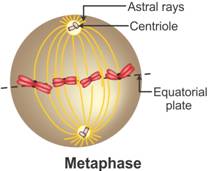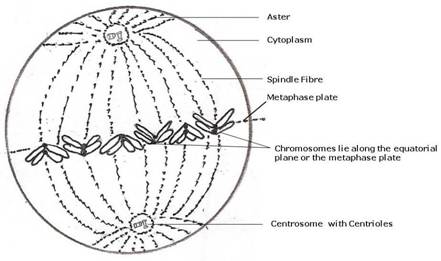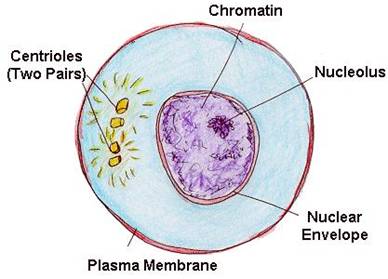Class 10 SELINA Solutions Biology Chapter 2 - Structure of Chromosomes, Cell Cycle and Cell Division
Structure of Chromosomes, Cell Cycle and Cell Division Exercise Ex. 1
Solution A.1
(b) DNA and Histones
Solution A.2
(c) Coloured bodies
Solution A.3
(c) both ovary and testis
Solution A.4
(c) DNA
Solution A.5
(b) Prophase, metaphase, anaphase, telophase
Solution A.6
(b) Movement
Solution A.7
(c) S phase
Solution A.8
(d) Guanine and Cytosine
Solution A.9
(b) 22 pairs
Solution A.10
(d) Karyokinesis
Solution A.11
(c) 44 + XX chromosomes
Solution A.12
(c) G1, S and G2
Solution A.13
(d) Telophase
Solution A.14
(c) Pentose sugar
Solution A.15
(b) 8
Solution A.16
(d) Thymine and Cytosine
Solution A.17
(c) 22 + X chromosomes
Solution B.1
(a) - Nucleotides.
(b) - Nucleosome.
(c) - Hydrogen Bond.
(d) - Phosphate, Sugar and Nitrogenous base.
Solution B.2
Cell A: 2
Cell B: 4
Solution B.3
|
Column 'A' |
Column 'B' (Answers) |
|
(a) Chromosomes become arranged in a horizontal plane at the equator |
Metaphase |
|
(b) Daughter chromosomes move to the opposite poles of a spindle |
Anaphase |
| (c) Chromosomes become visible as fine long threads | Prophase |
|
(d) Chromosomes lose their distinctiveness and gradually become transformed into a chromatin network |
Telophase |
Solution B.4
(a) DNA replicates in the synthesis (S) phase of the cell cycle.
(b) Mitosis occurs in our somatic (body) cells.
(c) Meiosis occurs only in reproductive (sex/germ) cells.
(d) Modern humans have 46 chromosomes. Their sperms and eggs will have 23 chromosomes each.
(e) During the pairing of chromosomes in meiosis, the homologous chromosomes come to lie side by side.
(f) The two non-sister chromatids of a paired chromosome are attached to each other at chaisma during the process of crossing over.
Solution C.1
(a) DNA and Histones (Proteins)
(b) DNA and RNA
(c) Pentose sugar, Phosphate group and Nitrogenous bases
(d) Adenine, Guanine, Thymine and Cytosine
(e) Purines and Pyrimidines
(f) DNA and 8 histones
(g) Mitosis and Meiosis
(h) Prophase, Metaphase, Anaphase and Telophase
(i) Karyokinesis and Cytokinesis
(j) Egg cell and Sperm cell
Solution C.2
Rungs of the DNA ladder are made of nitrogenous bases, which include Adenine (A), Guanine (G), Cytosine (C) and Thymine (T).
Solution C.3
(a) The four nitrogenous bases in the DNA ladder are Guanine, Thymine, Adenine and Cytosine.
(b) Genes are specific sequences of nucleotides on a chromosome.
(c) A nucleotide is composed of a phosphate, sugar (pentose) and a nitrogenous base.
(d) Nucleosomes are groups of histone molecules surrounded by DNA strands.
(e) If there are 46 chromosomes in a cell there will be 46 chromatin fibres inside the nucleus during interphase.
Solution D.1
(a) Chromosome: Chromosomes are highly condensed coiled chromatin fibres made of DNA which carry the hereditary material of the organisms.
(b) Gene: Genes are specific sequences of nucleotides on a chromosome that encode particular proteins which express in the form of some particular feature of the body.
(c) Cell division: Cell division is the method in which the cell divides and the duplicated chromosomes get evenly distributed into the daughter cells.
(d) Chromatid: Duplicated chromosomes consist of two identical strands, each of these is called a chromatid.
(e) Aster: Each centriole is surrounded by radiating rays and is termed aster.
Solution D.2
(a) Gametes must be produced by meiosis for sexual reproduction because the number of chromosomes is reduced to half during meiosis, and the normal diploid number of chromosomes is regained during the process of fertilisation.
(b) Meiosis is referred to as 'reductional division' because the number of chromosomes is reduced to half, i.e. out of the 23 pairs of chromosomes in humans, only a single set of chromosomes is passed on to the sex cells.
(c) The mixing up or recombination of genes during meiotic division provides innumerable variations and diversity in the progeny. That is how the children of the same parents, howsoever similar, are different from each other in certain aspects.
Solution D.3
(a) Differences between cytokinesis and karyokinesis:
|
Cytokinesis |
Karyokinesis |
|
1. It is the division of the cytoplasm. |
1. It is the division of the nucleus. |
|
2. It occurs after karyokinesis. |
2. It occurs before cytokinesis. |
|
3. It results in the formation of two daughter cells. |
3. It results in the formation of two nuclei. |
(b) Differences between DNA and RNA:
|
DNA |
RNA |
|
1. DNA is deoxyribonucleic acid. |
1. RNA is ribonucleic acid. |
|
2. It consists of four distinct bases: thymine, adenine, cytosine and guanine. |
2. It consists of four distinct bases: uracil, adenine, cytosine and guanine. |
|
3. It is located in the nucleus of a cell and the mitochondria. |
3. It is found in the cytoplasm, nucleus, and the ribosome. |
|
4. The DNA is a double-stranded molecule. |
4. The RNA is a single-stranded molecule. |
(c) Differences between nucleosome and nucleotide:
|
Nucleosome |
Nucleotide |
|
It is a complex made up of DNA wrapped around histone proteins. |
It consists of a phosphate group, a sugar and a nitrogenous base. |
(d) Differences between centrosome and centromere:
|
Centrosome |
Centromere |
|
1. It is an organelle of the animal cell. |
1. It is a non-stainable part of the chromosome at which two chromatids join. |
|
2. It contains two centrioles which move towards the opposite poles and form spindle fibres during cell division. |
2. It provides for the attachment of spindle fibres during cell division. |
(e) Differences between haploid and diploid:
|
Haploid |
Diploid |
|
1. It is a state of half the number of chromosomes than the original. |
1. It is a state of full set of chromosomes. |
|
2. It is denoted by n. |
2. It is denoted by 2n. |
|
3. This state is found during meiotic division. |
3. This state is found during mitotic division. |
Solution D.4
(a) DNA- Deoxyribonucleic acid
(b) RNA- Ribonucleic acid
Solution D.5
(a) Adrenaline (Rest are nitrogenous bases)
(b) Histones (Rest are components of a nucleotide)
(c) Interphase (Rest are phases of mitosis)
(d) M phase (Rest are phases of interphase)
(e) Chromosome (Rest are kinds of plastids)
Solution E.1
(a) 2
(b) 2 on each strand
(c) 1- Phosphate,2- Sugar, 3- Bases,4- Hydrogen Bond,5 - Base
(d)Nucleotide
Solution E.2
Solution E.3
a.
1 - Centromere
2 - Spindle fibres
3 - Chromatids
b. The stage described in the diagram is the late anaphase of mitosis in an animal cell. The stage can be identified by the presence of separated chromatids which are found at the two poles of the cell. The appearance of the furrow in the cell membrane classifies the stage as the late anaphase.
c. The division is mitotic division and this kind of cell division occurs in all the cells of the body except for the reproductive cells.
d. The stage before anaphase is metaphase.

Solution E.4

Solution E.5
The exchange of chromatids between homologous chromosomes is called crossing-over. This is the process by which the two chromosomes of a homologous pair exchange equal segments with each other.
Crossing over occurs in the first division of meiosis. At that stage each chromosome has replicated into two strands called sister chromatids. The two homologous chromosomes of a pair synapse, or come together. While the chromosomes are synapsed, breaks occur at corresponding points in two of the non-sister chromatids, i.e., in one chromatid of each chromosome.
Since the chromosomes are homologous, breaks at corresponding points mean that the segments that are broken off contain corresponding genes, i.e., alleles. The broken sections are then exchanged between the chromosomes to form complete new units, and each new recombined chromosome of the pair can go to a different daughter sex cell. It results in recombination of genes found on the same chromosome, called linked genes that would otherwise always be transmitted together.
Solution E.6
(a) Late prophase. Because the nuclear membrane and nucleolus have disappeared.
(b) Centrioles.
(c) 1 - Centromere
2 - Chromatids.
3 - Spindle fibre.
(d) Metaphase. The centromeres of chromosomes are drawn to the equator by equal pull of two chromosomal spindle fibres that connects each centromere to the opposite poles, forming a metaphasic plate.
(e)
|
Mitosis |
Meiosis |
|
(i) Two daughter cells are produced. |
(i) Four daughter cells are produced. |
|
(ii) It is equational division i.e. the number of chromosome in the daughter cells or parent cells remains the same. |
(ii) It is reductional division i.e. the number of chromosomes is reduced to half in the daughter cells. |
Solution E.7
(a) Metaphase.
(b) 4.
(c) A - Animal cell, B - Animal cell, C - Plant cell
During mitosis in plant cells, asters are not formed. Hence, figure C denotes a plant cell. Mitosis in animal cells involves the formation of asters. hence, figures A and B represent animal cells.
Solution E.8
(a) This is an animal cell because:
(i) The outline is circular (in plants it would be angular {rectangular or polygonal}) and cell wall is absent.
(ii) Centrosomes on centrioles are present. (These are found only in animal cells)
(b) Mitosis.
(c) B, C, D, A.
(d) Interphase.
(e)


